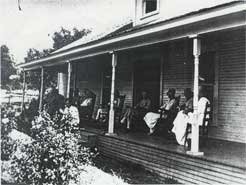< Back to About the Poor Farm
History of the Poor Farm
A Place for the Poor to Earn Their Living
 Commissioners Court of Parker County issued an order to purchase two tracts of land - 160 acres per tract - January 10, 1883 for the "purpose of the support of the paupers of Parker County." The price of the land at the time was $1900.00. This property is located approximately three miles south of the Weatherford Court House on Tin Top Road, known to local residents as Harmony Road. The idea behind the decision was to reduce monthly expenses from $10.00 to $3.00 per "indigent" and homeless person by moving these people out to the Poor Farm or County Farm. The house was a long barracks type with a long hallway and rooms on each side of the hall.
Commissioners Court of Parker County issued an order to purchase two tracts of land - 160 acres per tract - January 10, 1883 for the "purpose of the support of the paupers of Parker County." The price of the land at the time was $1900.00. This property is located approximately three miles south of the Weatherford Court House on Tin Top Road, known to local residents as Harmony Road. The idea behind the decision was to reduce monthly expenses from $10.00 to $3.00 per "indigent" and homeless person by moving these people out to the Poor Farm or County Farm. The house was a long barracks type with a long hallway and rooms on each side of the hall.
February 1, 1883, Mr. and Mrs. G. W. Abbott were employed to take charge of the County Farm or Poor Farm. December 7, 1887, the County Commissioners elected them to be superintendents of the farm until October 5, 1891 when T. H. Franklin replaced them. The following men supervised the farm until 1942: W. P. Cogdill, R. E. Hay, T. M. Moore, T. R. Coker, J. T. Aruett, Leonard Frazier, W. L. Byron, J. W. Sligar, J. M. Coffman, Felix Vance, Alvin Bielss, Charlie McMahon and G. W. Chamberlain. The job of superintendents was to grow crops and raise livestock, using able-bodied residents and county convicts who worked off their fines. The women would cook, clean, and take care of the inside. There may not have been much difference in their work roles as the rest of the county at that time in history.
Mrs. Alvin Bielss still resides in Parker County and can recall addressing residents as "aunt" and "uncle". The title aunt and uncle showed compassion towards the residents teaching their two children, Nila and Eldon, to respect people less fortunate, but still deserving respect.
Nila Bielss Seale can recall cooking for the residents and helping her mother carry the food across the road from the caretakers house to the elderly living there. As well, she can recall some very sad times on the farm such as illness, death and funerals. Burials were at the small pauper's cemetery across a creek and on a little hill from the caretaker's house. Nila can still recall a suicide and cancer. A man had cancer in his head and the appointed doctor did not come one day for treatment. Mr. Bielss poured horse medicine on the cancer site and it seemed to work.
The following persons lived on the farm until they died and buried on the farm while others were buried away. These names are taken from Cotton Bratton Funeral Home and Parker County Burial Records compiled by Mary Kemp and Billie Bell.
Tobe Kanedy died of heart failure at the age of 25 on January 3, 1904 and buried on the Poor Farm.
Frankie Long died of pulmonary congestion on July 20, 1906 and buried on the Poor Farm.
Mrs. Mary Cedarberry died October 5, 1910 at the age of 60 and buried on the Poor Farm.
Commissioner's notes show that June 14, 1887, Jim Morton was sent to live in a Confederate Home and on February 13, 1903 I. J. Stroope was awarded a confederate pension.
Before 1905, the county paid individuals for burying the paupers and digging the graves. In the 1870's, Carson and Lewis contracted to bury the paupers. May 12, 1979, E. W. Keller was allowed $2.00 to dig a grave and J. G. Sharp was awarded $5.00 to furnish a coffin. May 16, 1879, C. O. Hays was allowed $7.00 for a burial. July 10, 1880, Huggins & Williams contracted to furnish coffins. On February 16, 1905, J. T. Cotton was awarded the contract to bury paupers. March 1919 to May 1920, Cotton Bratton Furniture Company was given the contract for burials. W. A. White O Company contracted from August 1921 to January 1925. Then Cotton Bratton Furniture Company took over the contract until May 1944.
On February 24, 1941 the county granted an easement to Texas Public Utilities and August 2, 1941 Butane Gas was installed on the farm. These changes came about when Alvin Bielss was appointed superintendent.
The actual "Old Folks Home" was moved during World War II to Throckmorton Street until the 1960's when it was sold and moved to North Rusk Street where it is privately owned and named The Church of the Living God.
(From an anonymously written document written in the 1980's, when the historical marker at the Poor Farm was dedicated)